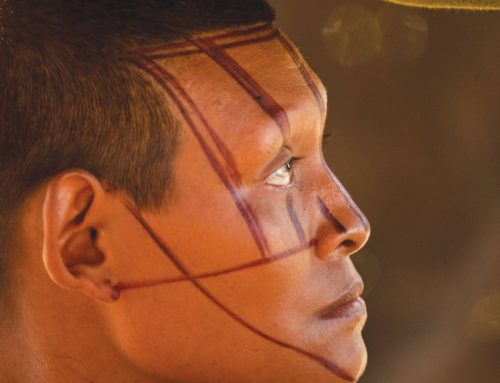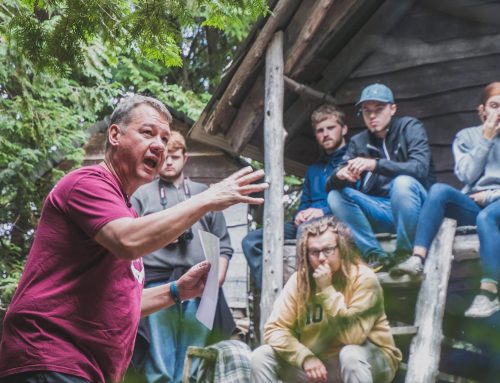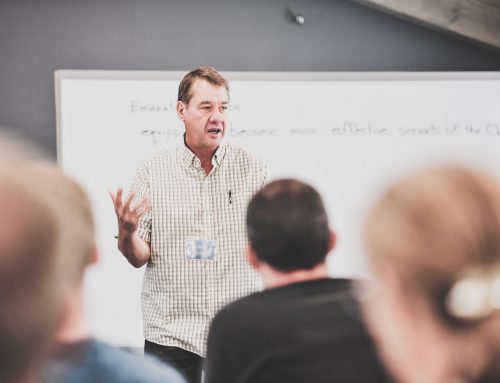One thing that we can be sure of is change. We live in a changing world — culture changes, fads are by nature changing, whatever “favourite” you have today may be changed tomorrow. On the other hand, we have an unchanging God, and it is He Who continues to work changes in each of our lives. Likewise, He has guided Ethnos through many changes over the years. Time and space won’t permit me to tell you the whole story, but I would like to take you on a journey that touches on the significant points from the formation of New Tribes Mission to who and what Ethnos is today. It’s a journey that God by His grace has allowed us to take.
It was back in 1942 that Paul Fleming, Bob Williams and Cecil Dye were led by God to start a mission agency for the purpose of sending eager missionaries to reach the unreached. In the spring of that year, New Tribes Mission was founded.

The mission quickly became global in membership.
The three men felt the need to have a pledge that would outline their God-given task. The burden on their hearts was to reach the last people group in their generation. Here is a portion of the Founders’ Pledge:
“We hereby pledge ourselves:
- To work for the completion of the Bride of Christ until death.
- To measure all of our effort in the light of this task.
- To refrain from doing even the good things if they do not contribute to the most important thing: namely, reaching the last unevangelized [people group] in our generation.
- To do nothing that would hinder or detract or render us powerless in the accomplishment of this goal.”
They were definitely not alone in the desire to go to the unreached. There were many young people, single and married, who longed to be used of God to reach people in remote locations with the news of Jesus Christ. Believers responded to the challenge, and the first group was sent to Bolivia in 1942; this group consisted of 10 adults and six children. In October 1943 five of those men were martyred in Bolivia attempting to reach the Ayoré people group.
Paul Fleming had the desire to see the mission engage in preaching the gospel in “10 countries in 10 years.” That goal was reached in only seven years. What had started in Bolivia continued to grow, and by 1954 the countries in which there were missionaries included Colombia, China, Venezuela, Brazil, India, Malay (now Malaysia), Paraguay, Japan, Papua New Guinea, Philippines, Thailand, Panama and Senegal.
Throughout the years, God moved hearts in multiple places around the world, nudging people to join the work of New Tribes Mission. The mission quickly became global in membership. As a missionary kid growing up in Panama in the late 1960s, I remember that we had missionaries serving in Panama from Canada, Germany, England, Australia, New Zealand, Holland, Denmark and the USA.
GROWING PAINS
You see, the mission had grown from that handful of missionaries to more than 3,000 members coming from multiple countries, languages and cultures. With such numerical growth came increased responsibilities for the Executive Committee that operated from the US home office. With the leadership on the fields being accountable to the Executive Committee, the Executive Committee was functioning as both the “US committee” and the “international committee.” This left little time to develop the structure for partnership and coordination between fields, among other things. They knew that change was needed and began seeking God’s direction.

As a missionary kid growing up in Panama in the late 1960s, I remember that we had missionaries serving in Panama, from Canada, Germany, England, Australia, New Zealand, Holland, Denmark and the USA.
In 2000 the Executive Committee formally concluded that a truly international partnership was the best way forward. At two forums ( 2001, 2002) where several countries were involved, it was agreed that God was indeed moving the mission toward a new global partnership with a new leadership structure. The countries involved identified several important issues to be considered:
- The International fellowship of entities would be collectively referred to as “Global Partners.”
- All those who would be included in this global partnership must be able to take ownership of the original mission’s values.
- Non-western input was needed.
- A new global leadership model was presented which would have a worldwide perspective and not be anchored to a single geographical region.
- Intercultural respect was promoted, resulting in harmonious teamwork.
- The Global Partners needed to agree on core doctrine, purpose and values.
- Sending countries should handle their own in-country organizational responsibilities.
In order to begin the lengthy process toward a network of global partners, New Tribes Mission’s Executive Committee was restructured into a US Sub-Committee and a Field Ministries Committee. The former took care of all things that pertained to the USA, its departments and training. The latter would be responsible for the following areas:
- Leading in articulating the needs, casting a vision, identifying priorities and formulating strategy in seeing that church planting and cultivation took place among all the unreached people groups in the world.
- Fostering complementary partnerships in church planting ministries among missionaries from western, non-western and tribal churches.
- Ensuring that all fields, both existing and planned, would have effective leadership teams and that every church planting team would receive timely consultant help at every stage of their ministry.
The Field Ministries Committee later became the International Ministries Team (IMT) whose main responsibilities were to give leadership to Field Leadership Teams and to build cohesiveness between sending and field entities. This team continues to bring unity and consistency in goals, strategy and methodology across the network of global partners.
ENTER THE GLOBAL MINISTRIES AGREEMENT
In January 2008, a task force made up of 13 men from 10 nations as well as some from the International Ministry Team was appointed to draft the Global Ministries Agreement (GMA). This document would provide the framework of the purpose, doctrine, core values, ministry values and policies for the new network of Global Partners. To be a Global Partner, the leadership of the entity must agree to abide by the framework outlined in the Global Ministries Agreement. Each entity that signs the Global Ministry Agreement maintains its own identity (e.g., Ethnos Canada is still Ethnos Canada) but becomes one of the Global Partners.
In April 2008, a GMA Board was proposed that would consist of nine members whose main responsibility would be to ensure that all Global Partners followed the Global Ministries Agreement. The GMA Board today has members coming from seven different nations.
In August 2009, there was a forum for the express purpose of introducing and signing the GMA by partner entities.
What had started in 1942 as a single missionary-sending organization known as New Tribes Mission has evolved into a fellowship of member entities that are closely bound together by their purpose and core values, their ministry distinctives (heart language ministries and clear translations of Scripture, for example) and their deep commitment to see the gospel taken to the unreached ethnic groups of the world. This fellowship is called Global Partners.
Global Partner members work to expand the Church beyond the edge where the Church now exists.

This document would provide the framework of the purpose, doctrine, core values, ministry values and policies for the new network of Global Partners.
PRESENT REALITIES
There are four leadership teams that provide direction in specific areas within Global Partners.
- On each field, ministry initiatives are led by Field Leadership Teams that give direct leadership and shepherding to the church planting ministries in the unreached people groups.
- The International Ministries Team (IMT) provides leadership and support for any Global Partner’s ministry initiatives, consultant teams and church planting teams in the carrying out of ministry purposes around the world.The IMT defines the equipping strategies (known as e1, e2, e3 — see sidebar for explanations), sets the standards and helps to form the curriculum of the e1 training. They assist the Field Leadership Teams with guidance and consultative help for the church planting teams.
- The Global Ministry Agreement Board (GMA Board) is a leadership team who serves all Global Partners by maintaining clarity regarding the commitments that bind us together in the GMA. The GMA Board is accountable to all the Global Partners.
- Sending entities recruit, train, mobilize, connect with sending churches and tend to any other logistical service that helps keep members on the field.
All entities are equal Global Partners, whether they are fulfilling a sending role or a field role or both roles. The ultimate goal of all Global Partners is to see maturing churches planted that will continue to multiply.
As of 2021, there are 31 entities that comprise the network we call Global Partners.
Before he even joined New Tribes Mission, he went on a mission to reach Iceland with the gospel — at the age of 18.


THE STORY OF ONE MAN
I want you to meet Oli Jacobsen, a good friend of mine who actually gave me most of this history lesson. His life was key in seeing New Tribes Mission through this whole process of becoming the network of global partners it is today (Global Partners).
He was born and raised in the Faroe Islands, those dots of land out in the North Sea between Scotland and Iceland. Before he even joined New Tribes Mission, he went on a mission to reach Iceland with the gospel — at the age of 18. While back in the Faroe Islands, he was challenged to further ministry to unreached people groups by an Englishman visiting the Faroe Islands. Since he had a limited knowledge of English, the Englishman helped him fill in the application to attend the training facility in the USA. It turns out that he along with a friend from the Faroe Islands were the first people from the Faroe Islands to be trained in the USA with New Tribes Mission.
Being a good language learner (English was his fourth language), he was able to complete the missions training course (then known as “boot camp”) and went on to the language institute to continue training in preparation for reaching an unreached people group. The Lord had other plans for him, though: he was married in 1968 to Judy who is from Wisconsin. Both of her parents were born and raised in Germany. So, both Judy and Oli have European roots. They were asked to stay on as staff at the language institute, and in 1976 he became the institute’s director.
After seven years as director, they were asked to move to the Philippines. He served as the director of that field for 10 years.
In 1994, they moved back to the USA to become part of the Executive Committee for the mission, and he became the chairman of the Executive Committee in 2001, ministering in that position until 2007.
At that time, due to his involvement in the move to internationalize the mission, he became the chairman of the International Ministries as well as the chairman of the GMA Board. The main responsibilities he has in this ministry involve extensive travelling to Global Partner entities worldwide, speaking and being an encouragement to the missionaries at their field conferences as well as helping leadership teams in their responsibilities. He has also been very involved in working with some of the newer sending entities of Global Partners in Europe and Asia.
I stand amazed at how God has worked through Oli Jacobsen’s life. Did you see the progression from being a non-English speaker to taking the New Tribes Mission training in English to ministering as a leader in that same mission? And then did you notice that he was the leader of the team that was involved in the change-over from its being a primarily America-based mission to the global partnership it is now? Oli was blessed to lead a multinational team of godly, wise men who had a wealth of experience in their various countries, and together they helped implement the paradigm shift and were able to bring about the creation of the Global Ministry Agreement that binds us together as a global team called Global Partners.

What started out as a tiny body of American missionaries has blossomed into a multi-ethnic, multicultural and multifaceted body of believers with one goal — reaching the unreached with the story of God’s love and grace.
SOME FINAL THOUGHTS
Thinking back to Oli’s trek from the Faroes to the USA for training, it is encouraging to note that now there are 10 training centres globally to train missionaries from different countries and cultures, and that number is steadily increasing.
Where do we stand, then, as a mission? Some people may still think that Ethnos360 USA is the leadership team for the Global Partners. Not so. Ethnos360 is an equal member among the Global Partners, and its leadership team (the Ethnos360 Executive Leadership Team) is at the same level of leadership as the leadership teams of the United Kingdom, Germany, Brazil, Colombia, Canada or any other entity.
As of this year, there are 2,327 missionaries working together with Global Partners, ministering among 263 people groups. (Of that number of missionaries, about 1,350 were sent out from Ethnos360 USA.) There are 96 completed translations of the New Testament (usually with portions of the Old Testament as well) with 123 in progress.
What started out as a tiny body of American missionaries has blossomed into a multi-ethnic, multicultural and multifaceted body of believers with one goal — reaching the unreached with the story of God’s love and grace. The process by which a group of people grew into a network of global entities known as Global Partners reminds me of some verses penned by the Apostle Paul.

But now God has set the members, each one of them in the body just as He pleased.
“For as the body is one and has many members, but all the members of that one body, being many, are one body, so also is Christ. For by one Spirit we were all baptized into one body — whether Jews or Greeks, whether slaves or free — and have all been made to drink into one Spirit. For in fact the body is not one member but many. … But now God has set the members, each one of them, in the body just as He pleased. … [T]here should be no schism in the body, but the members should have the same care for one another. And if one member suffers, all the members suffer with it; or if one member is honoured, all the members rejoice with it. Now you are the body of Christ, and members individually” (I Corinthians 12: 12-14, 18, 25-27).
Let us carry on until He returns, labouring, praying, giving and going in order to see a thriving church for every people group around our globe. May our Lord find us faithful to the task He has given us to go into all the world.

About the Author
Bruce Enemark was raised in Panama, the youngest of three missionary kids (MKs). He and Julie, his wife, ministered with Ethnos360 in Panama and Paraguay for 24 years before he joined Ethnos360’s Advancement team as a writer and proofreader. Faith Baptist Church of Chetek, Wisconsin, is their sending church and has been behind the Enemarks since they started their ministry with Ethnos360.






